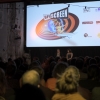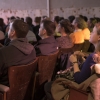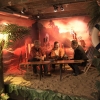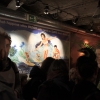ROGER CORMAN | Offscreen
"King of the B-movie" was an honorary title that he was only too happy to endorse and commercialize. In the 1950s, Corman churned out one exploitation picture after another for American International Pictures—if possible, in just two days and one night. But alongside dozens of entertaining and sensational genre films, his filmography also contains more than a dozen cult classics.
House of Usher, shot in color with a considerably higher budget, was a major financial gamble, but the film’s success marked the beginning of one of the greatest multi-film actor/director collaborations in the horror genre: the one between Corman and Vincent Price. The colorful and baroque visual splendor, the successful balance of atmosphere and design, and the infusion of Gothic horror with a melancholy and existential dread made Corman, surprisingly, an “auteur” of the better B-movie—in other words, B+.
This, among other things, led to him being able to make a film for a major studio like Fox in 1967. The St. Valentine’s Day Massacre is a subversive and intelligent gangster film that is somewhat unjustly forgotten. The experience, however, left Corman disgusted with the incredible waste of time and money that goes hand in hand with typical big Hollywood productions. He ultimately found greater satisfaction in founding his own production company, New World Pictures.
HOUSE OF USHER
Eight times, cult director Roger Corman drew on the work of American horror writer Edgar Allan Poe. His very first adaptation was House of Usher (based on the short story The Fall of the House of Usher), set in the 19th century, about Philip Winthrop, who is engaged to Madeline Usher, a young woman from an apparently cursed family. Her brother Roderick—who looks like a living corpse—tries to make this clear to Philip. The eerie, yet at times also humorous, House of Usher is widely regarded as one of the highlights of the prolific Roger Corman’s body of work.
THE ST. VALENTINE'S DAY MASSACRE
February 14, 1929. Al Capone finally establishes himself as the head of organized crime in Chicago. In a garage in the city’s north side, his gangsters—disguised as police officers—surprise the main members of Bugs Moran’s rival gang and mow them down with machine guns in the infamous massacre that gives the film its title.








